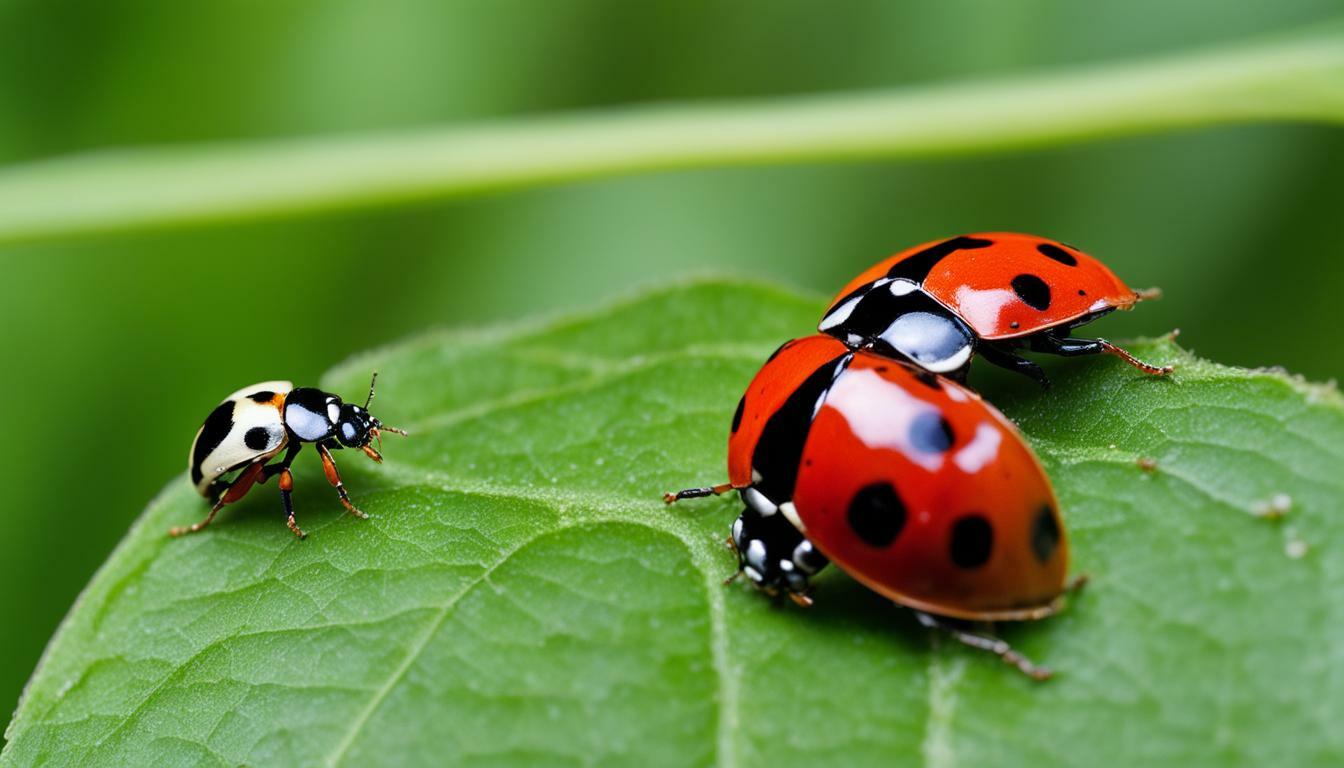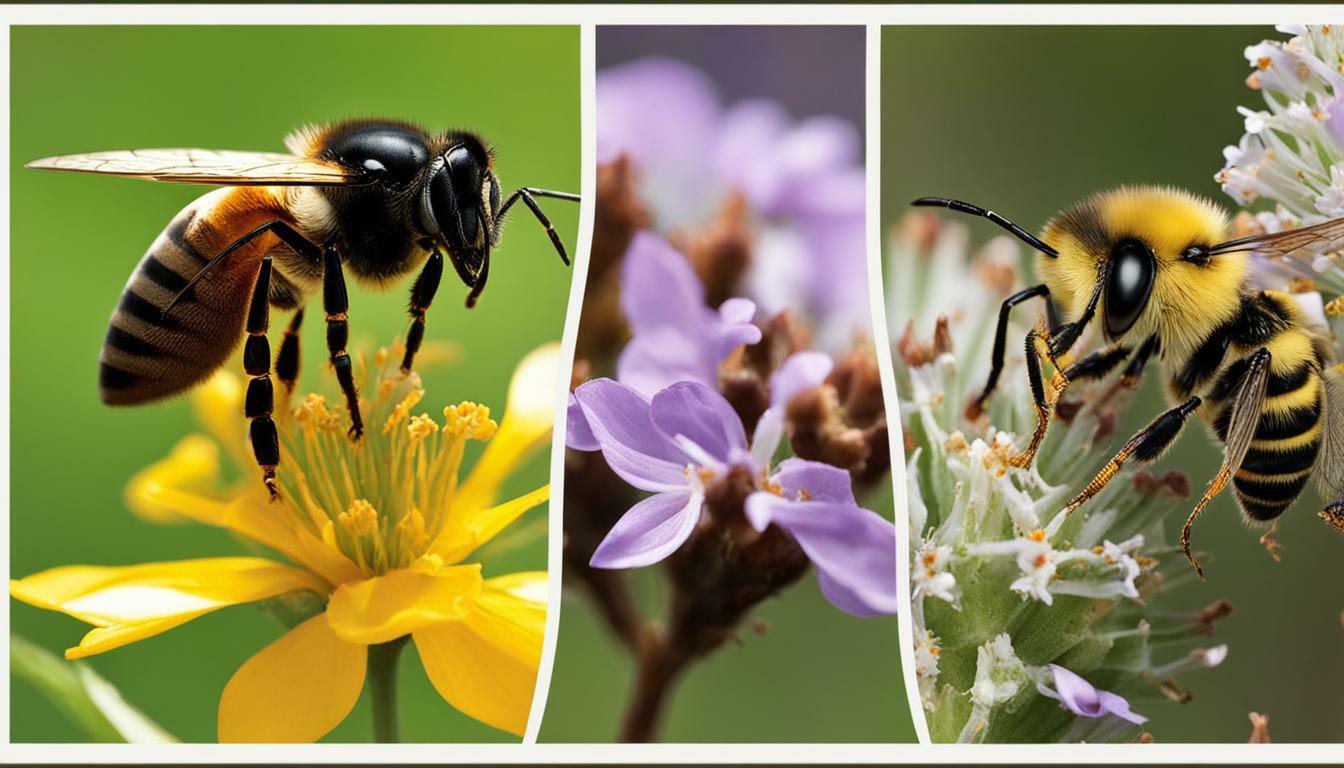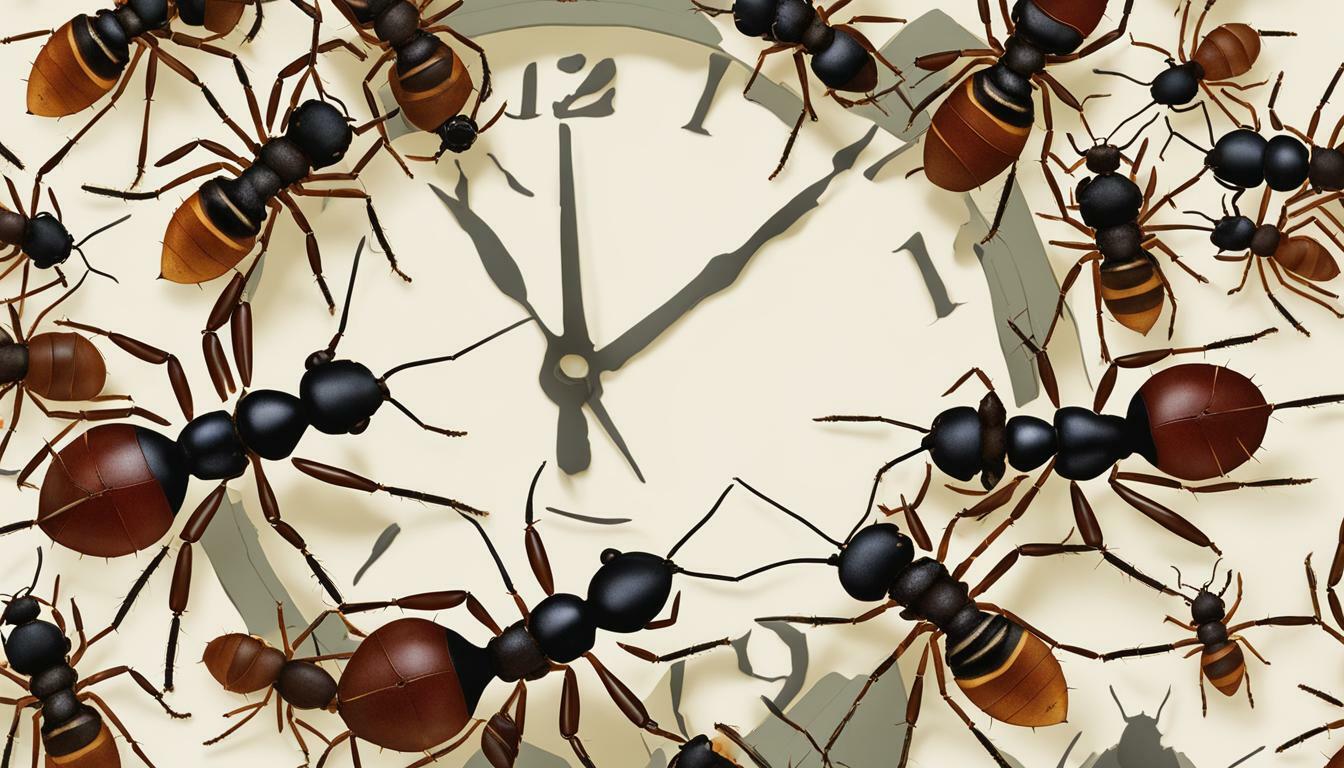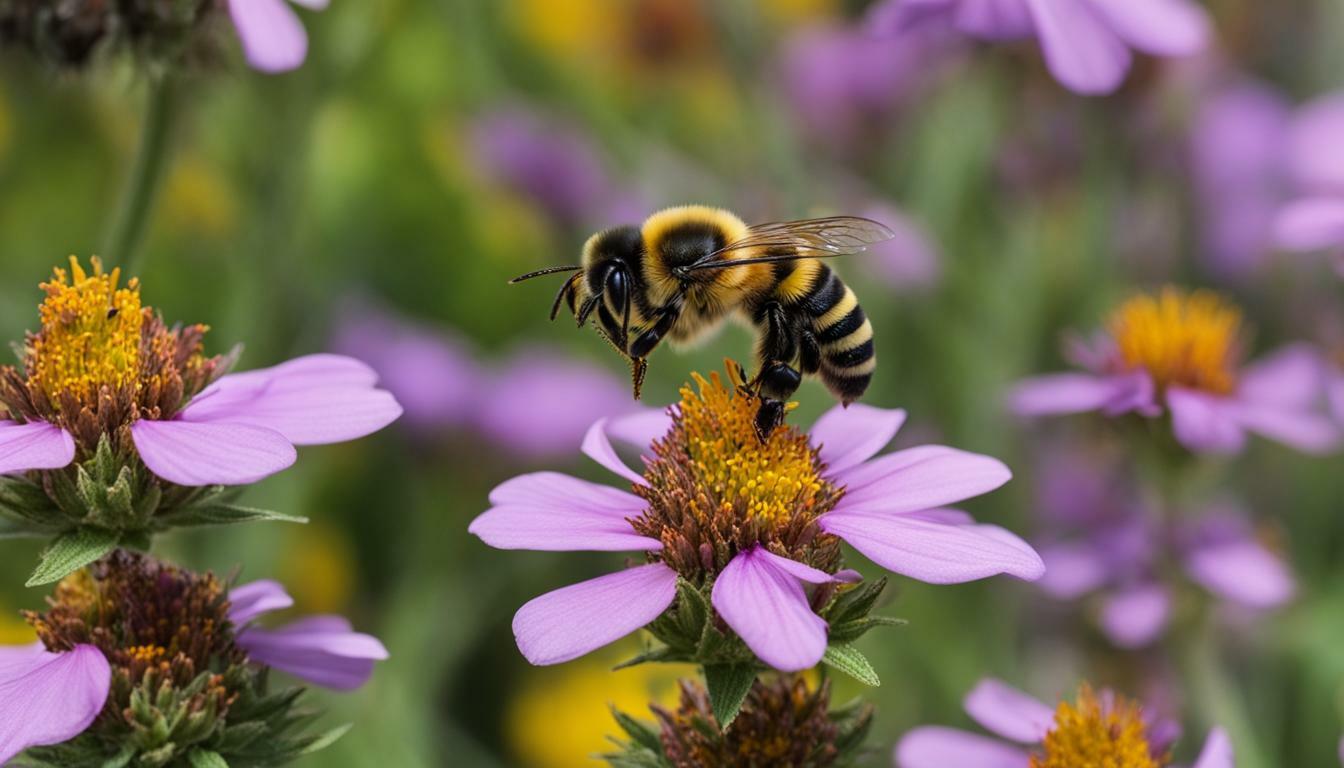Ladybugs and Asian lady beetles are often confused with each other due to their similar coloring and physical appearance. However, these two insects are distinct from each other in several crucial ways. In this article, we will explore the differences between these two fascinating creatures, including their characteristics, habitats, and ecological significance.
Key Takeaways:
- Ladybugs and Asian lady beetles have several key differences that set them apart from each other.
- The two insects differ in their physical appearance, behavior, preferred habitats, and dietary preferences.
- Both ladybugs and Asian lady beetles play important roles in pest control and ecosystem preservation, making them valuable components of our environment.
Ladybugs and Asian Lady Beetles: Identification and Appearance
Ladybugs and Asian lady beetles are often mistaken for each other due to their similar appearance. However, there are several key differences that can help in identifying them.
Ladybugs, also known as ladybirds, are small, round beetles that typically measure between 1 and 10 millimeters in length. They are usually red or orange in color with black spots on their wing covers. Some ladybugs may also have white or yellow spots. Their bodies are dome-shaped with short legs and antennae.
In contrast, Asian lady beetles are slightly larger than ladybugs and can grow up to 1.5 centimeters in length. They have a more oval shape and their color can range from yellow to dark orange. Unlike ladybugs, Asian lady beetles have a white marking on their black head. They also have a distinguishing M-shaped black marking on their thorax.
Another identifying feature of Asian lady beetles is their habit of clustering together in large numbers during the fall months. Ladybugs do not display this behavior.
Understanding the Habits and Behavior of Ladybugs
Ladybugs are fascinating insects that belong to the Coccinellidae family and are widely recognized for their flamboyant colors and distinctive spots. These small, oval-shaped creatures are about 0.3 to 0.4 inches long and can be found in all continents except Antarctica.
Ladybugs are commonly found in gardens and fields, where they feed on aphids and other small insects, making them beneficial to agriculture. They also tend to congregate in large numbers during the winter, often seeking warmth and shelter in homes and buildings.
In terms of diet, ladybugs are known to be voracious predators, and some species can consume up to 50 aphids per day, making them an essential part of the ecosystem. They are also known to feed on mites, scale insects, and mealybugs, making them valuable in pest control.
| Characteristics of Ladybugs | Ladybugs Habitat |
|---|---|
| – Brightly colored with distinctive spots | – Gardens and fields |
| – Oval-shaped and approximately 0.3 to 0.4 inches long | – Can be found in all continents except Antarctica |
| – Voracious predators, consuming up to 50 aphids per day | – Seek warmth and shelter in homes and buildings during winter |
| – Feed on aphids, mites, scale insects, and mealybugs | – Preferred food sources include aphids, mites, and mealybugs |
Overall, ladybugs are highly beneficial to the ecosystem, serving as natural pest control agents and pollinators. Their adaptability and unique characteristics make them valuable contributors to the biodiversity of our planet, and their presence should be celebrated and protected.
Exploring the Traits and Behavior of Asian Lady Beetles
Unlike their more well-known counterparts, ladybugs, Asian lady beetles have some distinct features and behaviors that set them apart.
Characteristics of Asian Lady Beetles
Asian lady beetles are slightly larger than ladybugs, with a more oval-shaped body and a distinctive M-shaped black marking on their pronotum. They come in a range of colors from yellow to orange, and their spots can vary from none to many.
One of the most interesting features of Asian lady beetles is their ability to release a yellowish, foul-smelling liquid from their legs when threatened, which can deter predators.
Asian Lady Beetles Habitat
Asian lady beetles prefer to live in wooded areas, especially areas with oak and maple trees. They are known to congregate in large numbers during the fall, seeking shelter in homes and other structures for the winter months. This tendency to invade homes has led to them being considered a nuisance pest by many homeowners.
Asian Lady Beetles Diet
Asian lady beetles have a varied diet, with both plant and animal matter on the menu. They are known to feed on aphids, scale insects, and other soft-bodied insects, making them a valuable asset in pest control. However, they have also been known to feed on fruits, soybeans, and other crops, causing damage to agricultural industries in some areas.
Overall, Asian lady beetles have some unique characteristics and behaviors that distinguish them from ladybugs. While they have some benefits in pest control, their tendency to invade homes and feed on crops has made them a somewhat controversial insect in certain areas.
Ladybugs and Asian Lady Beetles: a Comparative Analysis
While ladybugs and Asian lady beetles may seem similar at first glance, a closer examination reveals distinct differences between the two.
| Aspect | Ladybugs | Asian Lady Beetles |
|---|---|---|
| Physical Appearance | Ladybugs are typically smaller and rounder than Asian lady beetles, with a red or orange body and black spots. They have a more circular dome-shaped body. | Asian lady beetles have a slightly more oval shape with a brighter orange color and may have more spots than ladybugs. The beetles also have a distinctive M-shaped marking on their thorax. |
| Behavior | Ladybugs are known to be less aggressive than Asian lady beetles. They tend to be solitary insects, except during the winter when they may cluster together for warmth. | Asian lady beetles are more aggressive and known to bite humans. They also tend to form large swarms, particularly during the fall. |
| Ecological Role | Ladybugs are important in the ecosystem for their role in pest control. They feed on harmful insects such as aphids, mites, and scale insects, helping to protect crops and plants. | Asian lady beetles also play a role in pest control but have been known to consume beneficial insects as well. They also play a role in pollination. |
Overall, while ladybugs and Asian lady beetles may seem similar on the surface, a closer look reveals notable differences in appearance, behavior, and ecological significance.
Ecological Importance of Ladybugs and Asian Lady Beetles
Both ladybugs and Asian lady beetles play a critical role in our ecosystem. They are known for their voracious appetite for aphids and other agricultural pests, making them an important natural form of pest control. By consuming these pests, they help safeguard crops and reduce the need for chemical pesticides, thereby promoting sustainable agriculture.
In addition to pest control, ladybugs and Asian lady beetles also have an important role in pollination. They are known to feed on nectar and pollen, which helps transfer pollen from one plant to another, aiding in plant reproduction. This makes them essential in maintaining biodiversity and a healthy ecosystem.
Another aspect of the ecological importance of ladybugs and Asian lady beetles is their use in medical research. Scientists have been studying ladybug blood as a potential treatment for AIDS and other diseases due to its antiviral and antibacterial properties.
In conclusion, the prominence of ladybugs and Asian lady beetles in our ecosystem cannot be overstated. Their role in pest control, pollination, and medical research highlights their individual importance in maintaining a balanced and healthy environment.
Ladybugs and Asian Lady Beetles: Interactions with Humans
Ladybugs and Asian lady beetles are generally considered beneficial insects, thanks to their role in controlling agricultural pests. However, their presence in homes and buildings can be a cause for concern, leading to mixed opinions on their interactions with humans.
One of the main issues with ladybugs and Asian lady beetles is their tendency to seek shelter in homes during the winter months. While they are harmless to humans and do not cause any structural damage, their large numbers can become a nuisance, resulting in unwanted stains and odors.
Conversely, ladybugs are often welcomed into gardens and farms as a natural form of pest control, thanks to their voracious appetite for aphids and mites. In contrast, Asian lady beetles have been known to cause damage to crops and vegetation by feeding on the sap and fruit.
In terms of anecdotes, ladybugs have long been considered a symbol of good luck and are often portrayed in children’s stories and cartoons. In contrast, Asian lady beetles have a reputation for being more aggressive and prone to biting, leading to negative associations and misconceptions.
Overall, while the presence of ladybugs and Asian lady beetles can have both pros and cons for humans, their importance in our ecosystem cannot be overstated. Whether they are providing natural pest control or helping to pollinate plants, these small insects play a crucial role in maintaining the balance of our environment.
Conclusion
Ladybugs and Asian lady beetles may appear similar at first glance, but as we’ve seen in this article, they have distinct differences. Ladybugs are a vital part of our ecosystem, playing a significant role in pest control and pollination. On the other hand, Asian lady beetles are considered an invasive species, and their presence in homes can be a nuisance to some people.
While both ladybugs and Asian lady beetles have their unique characteristics, it’s important to understand their differences to appreciate their ecological significance fully. We hope this article has shed some light on the differences between these two insects and their respective roles in our ecosystem.
It’s essential to remember that, regardless of their differences, ladybugs and Asian lady beetles are both important parts of our natural world. We should strive to protect and preserve them both as they contribute significantly to our ecosystem’s balance.
FAQ
Q: What is the difference between ladybugs and Asian lady beetles?
A: Ladybugs and Asian lady beetles are both beetles, but they belong to different species. Ladybugs are part of the Coccinellidae family, while Asian lady beetles are a type of lady beetle known as Harmonia axyridis. They have different physical characteristics and behaviors.
Q: How can I identify ladybugs and Asian lady beetles?
A: Ladybugs are usually small, round beetles with a red or orange body and black spots. Asian lady beetles, on the other hand, can vary in color from yellow to red and may have spots or no spots at all. They also have a distinctive M-shaped mark on their thorax.
Q: What are the habits and behavior of ladybugs?
A: Ladybugs are beneficial insects known for their appetite for aphids and other garden pests. They typically live in gardens, meadows, and wooded areas. Ladybugs also hibernate during the winter months in groups, often choosing sheltered spots like tree bark or inside houses.
Q: What are the traits and behavior of Asian lady beetles?
A: Asian lady beetles are also beneficial insects that feed on aphids and other small insects. They are known to be more aggressive than ladybugs and may bite humans if they feel threatened. Asian lady beetles also tend to congregate in large numbers, especially during the autumn months.
Q: How do ladybugs and Asian lady beetles compare?
A: Ladybugs and Asian lady beetles share similarities in their ecological roles as predators of garden pests. However, they differ in physical appearance, behavior, and habits. Ladybugs have a rounder shape, while Asian lady beetles can appear more elongated. Additionally, ladybugs are less likely to bite humans compared to Asian lady beetles.
Q: What is the ecological importance of ladybugs and Asian lady beetles?
A: Ladybugs and Asian lady beetles play a crucial role in our ecosystem by controlling populations of aphids and other harmful insects. They contribute to the overall health and balance of ecosystems through their predation, helping to maintain biodiversity and reduce the need for chemical pesticides.
Q: How do ladybugs and Asian lady beetles interact with humans?
A: Ladybugs are generally seen as beneficial insects and are welcomed in gardens for their pest control abilities. However, Asian lady beetles can be more invasive and may seek shelter indoors during the colder months, leading to their presence in homes. While they can be a nuisance, they also provide pest control benefits.
 Skip to main content
Skip to main content


